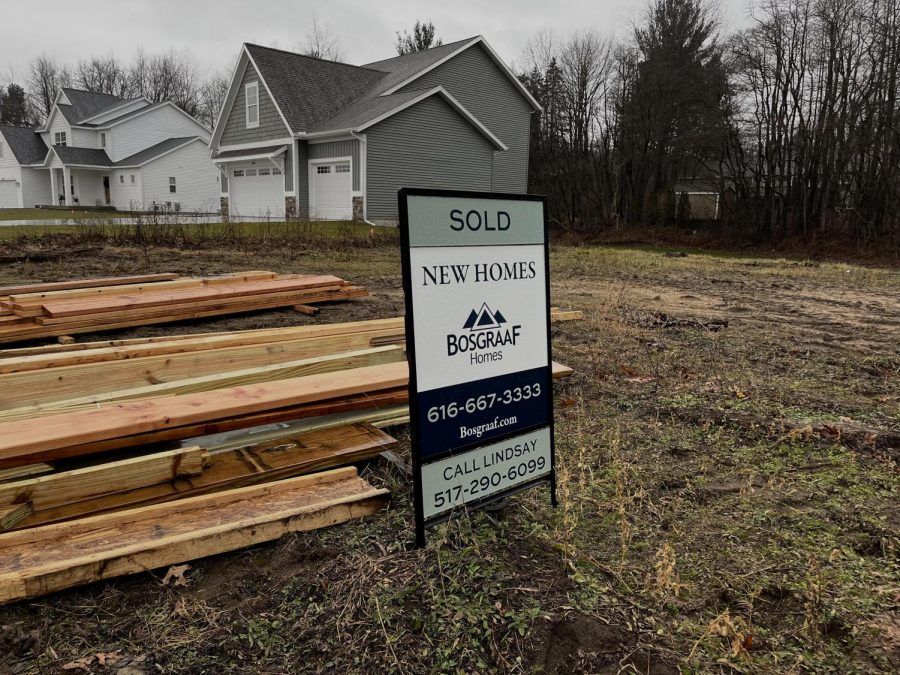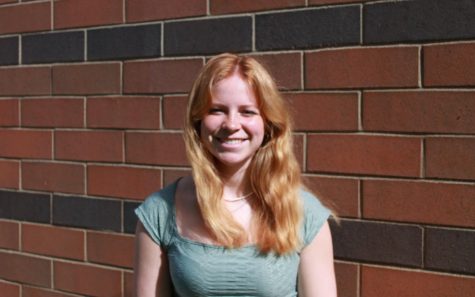There’s no place like home, for those who can afford one
Recent sold property sign in a Holland neighborhood.
January 25, 2023
Home is where the heart is. But what happens when a home is not available? Where does the heart reside then?
In Ottawa County, thousands are struggling to find that home.
The Problem
Holland is experiencing its most rampant population increase in recent history. People are looking to get away from the big cities and move to a more peaceful setting, putting more stress on the housing market.
Between 2009 and 2017, Ottawa County added nearly 40,000 jobs to the market, an increase of nearly 34%. The increase in jobs brings an increase in population, and the housing market cannot keep up.
The competition for new houses, and what’s left of the current supply, drives the pricing up. Oftentimes, there are affordable ‘homes’ available, but none that would be a feasible living space. Meaning, they might not be well taken care of, or just too small.
Political activist and West Michigan native Joe Spaulding said, “A home can either be affordable or a good investment.” Implying for those who want a suitable long term home, it will cost a pretty penny.
A simple example is a three bedroom, two bathroom, 1849 square foot house recently for sale on Zillow in the Holland area for $350,000. The home was originally valued at $179,300 in April, 2013. In just 10 years, this house, like many others, increased its value by over $170,000 – almost double its original price.
The process is simple: when upper class individuals are stripped of housing suitable for their incomes, they are forced to buy those of lower economic classes; Resulting in an increase in price on the more affordable buildings because of the increase in demand. Unfortunately, it also forces out the people who need these homes because they can’t afford a more expensive one.
But the problem isn’t necessarily focused on a certain social class, either. Research has shown that the greatest need appears to be for the middle-income households, but there is also a significant need for low-income and high-income households.
The overall estimated housing gap in 2025 is predicted to be 11,346 total units – almost triple from 2018. Including, 1,321 housing units priced between $100,000 and $149,999, 5,117 units priced between $150,000 and $249,999, and 4,908 units priced above $250,000.
“We need people at all different economic levels to live here in order to have a thriving community,” said Holland’s Mayor Nathan Bocks.
But what are upper class individuals really losing? Yes, they might not get the house they are looking for, or are disappointed in what they are spending compared to receiving, but this doesn’t compare to the circumstances of others.
What about the old man stationed on the corner of US-31 and James? The sign in his hand reading “Homeless father of two. Please. Anything helps?”
A real person, most likely neglected from his family or job, unable to afford the steps needed to pull his life back together. His story is similar to hundreds of others in the same area: people who aren’t able to afford a down payment with the rapid increase in the pricing of houses that are available.
Yes, sometimes these issues can be the outcome of poor decisions made earlier in life, but this isn’t not always the case.
What about the cashier who rings up your groceries every Sunday at Meijer? A 35-year-old woman with two kids, finally deciding she’s had enough of the abuse from her husband. She’s searched the market hundreds of times for an affordable apartment in a good environment to raise her two sons, but the closest home available to her price range would require her to get another job on top of the two she already has.
These are real issues victims of domestic violence face. They didn’t choose this situation. They had no idea when they were getting married their partner was going to be physically or mentally abusive. As much as they want to, they aren’t able to leave their abuser without accepting that they can either stay where they are, or spend every night on a park bench because they cannot afford the cost to pack up and leave.
A representative from the Resilience domestic violence and abuse shelter in Holland said, “It costs around $35,000 to leave an abusive relationship.” Housing can be a huge chunk of that. In a domestically violent relationship, the victim can experience an extreme lack of independence; Including financial independence. Meaning, although the victim needs to escape their abuser, they don’t have the financial stability to afford the necessary steps that need to be taken; and the biggest financial issue is the shelter over their heads.
Wake up, Holland. There are people in your city who would rather stay in a domestically violent relationship because their only other option is to live out on the street.
The Laws of the Land
Another problem preventing Holland from change is the fact that builders and city officials need to be smart about what they are doing with limited land. They have to keep in mind, it’s just as valuable to have fields of trees as it is skyscrapers. We don’t want to push to maximum capacity everywhere and cause economic and environmental destruction.
Also, when buying land in Michigan, there are laws and guidelines set for what owners can and cannot do with the land. For example, in a suburban neighborhood, there may be a law prohibiting a building over 35 feet in height. These laws make sure there aren’t structures like outlet malls in between two houses.
With these laws, however, comes other repercussions acting in a manner that would prohibit the building of useful complexes (such as affordable apartments) in areas they would otherwise strive in.
The Few People Who Care
Although Holland may not be able to support the population looking for housing, it does provide services to help.
HousingNext is a nonprofit company working with Holland’s bureaucrats to “put the pieces of responsible community development together to address our region’s housing problem.” They give the zoning/planning powers to City Hall, but take responsibility in making sure each neighborhood is a healthy, fair place to live.
The city of Holland officials are also trying their best. Bocks said, “Building is not something that we have the ability to do or the authority to do, so what we’re able to do is try to create an environment that makes it more attractive for developers or private individuals to build houses. There’s four ways that we do that: plan, invest, zone and abate (PIZA).”
Planning is the process that determines what kinds of buildings can be fabricated in different places. It also includes processes that plan and create neighborhood commercial districts (restaurants, stores) on the second or third floor of a building, allowing smaller sized rental and living units, and overall planning to increase the amount of suitable housing available.
Investing is all about economic relations. This includes the tax dollars used for infrastructure, roads, waterlines, etc.
Zoning, as mentioned before, determines what kind of construction is able to be built in certain areas.
“By trying to do good zoning we make it more attractive to people to live. We completely rewrote the zoning and planning codes for the city of Holland – some of which were 75-80 years old and tried to modernize it to make it easier for developers to be able to build as well as new neighborhoods and new types of properties,“ said Bocks.
Abating is the ability to give property tax discounts. Meaning, the government can say to a builder, if they build a certain kind of property, they will give a 50% discount on those property taxes for the next ten years. This is used when they think they are going to be building things attractive to the community and good for the people of Holland.
So What?
Access to affordable housing is the key to reducing inter-generational poverty and increasing economic mobility, impacting all different types of populations. With an influx in population that has nowhere to stay, these people will eventually leave, causing harm to the companies that hired them and the unattended jobs now needing to be filled.
Growing up in Holland, people realize the beauty of the place they call home. Because of this, they plan to never leave. But where are they going to go? Holland doesn’t have available homes for recently graduated college students looking to settle down while making $30,000 a year.
Additionally, as this issue continues to progress, Holland becomes less financially-diverse in the process. When the only housing available are homes listed for $600,000, the only people left will be the rich and upper-middle class.
Just because some people get to wake up every morning with heat and proper electricity, doesn’t mean everyone else has the same privilege. The entirety of Holland, including builders, city council, and residents is making it harder and harder for that cold, metal park bench to become a warm bed.
There are people suffering because of this issue and thousands more that are unaware.
The problem is to the point where it cannot be ignored anymore. Too many people are affected, and not enough is being done.
It’s time for the people of Holland to get involved and become informed on the problem at hand.
Residents can attend town hall meetings, look into what laws have been passed or already exist, zoning/building regulations, and processes being taken to fulfill PIZA. Even the simple solution of spreading more awareness on the issue to other residents can benefit the community as a whole.






Richard Kidd • Jan 30, 2023 at 8:01 am
Within that, rent is absolutely outrageous in the Holland area. So it goes like this;
My credit score says I can’t afford an $800 dollar a month mortgage, therefore I pay $1800 a month for rent. It’s really quite stupid.